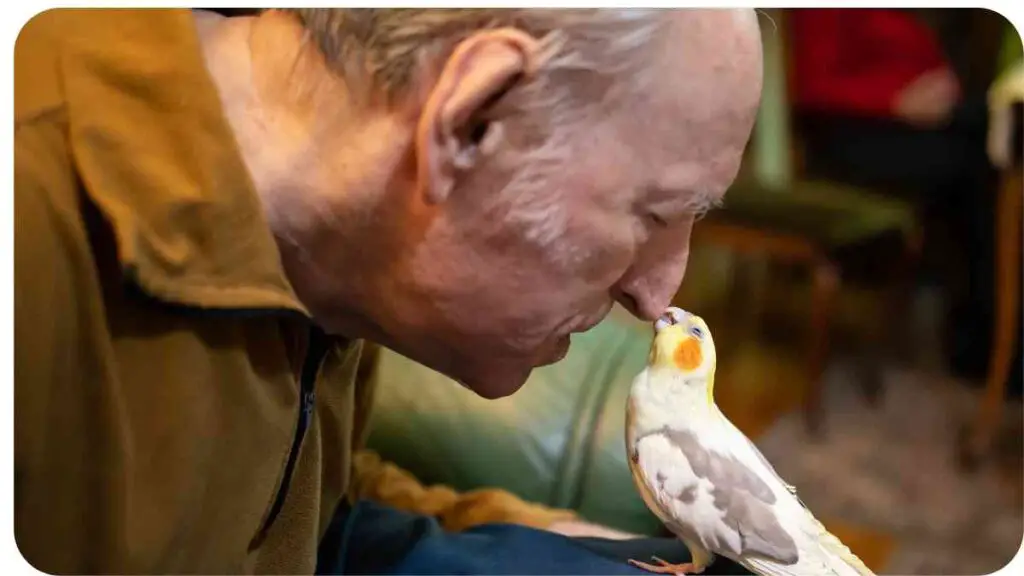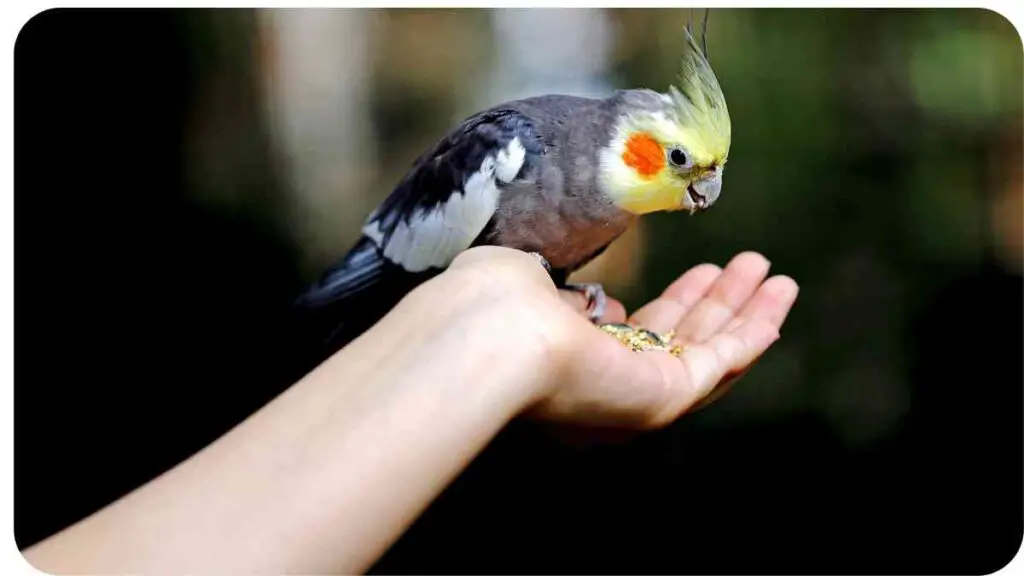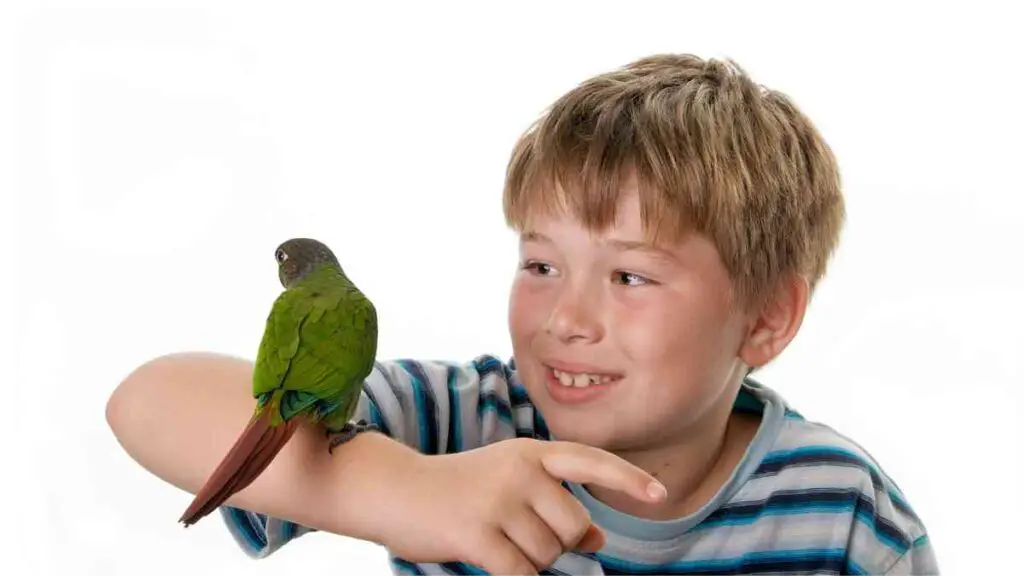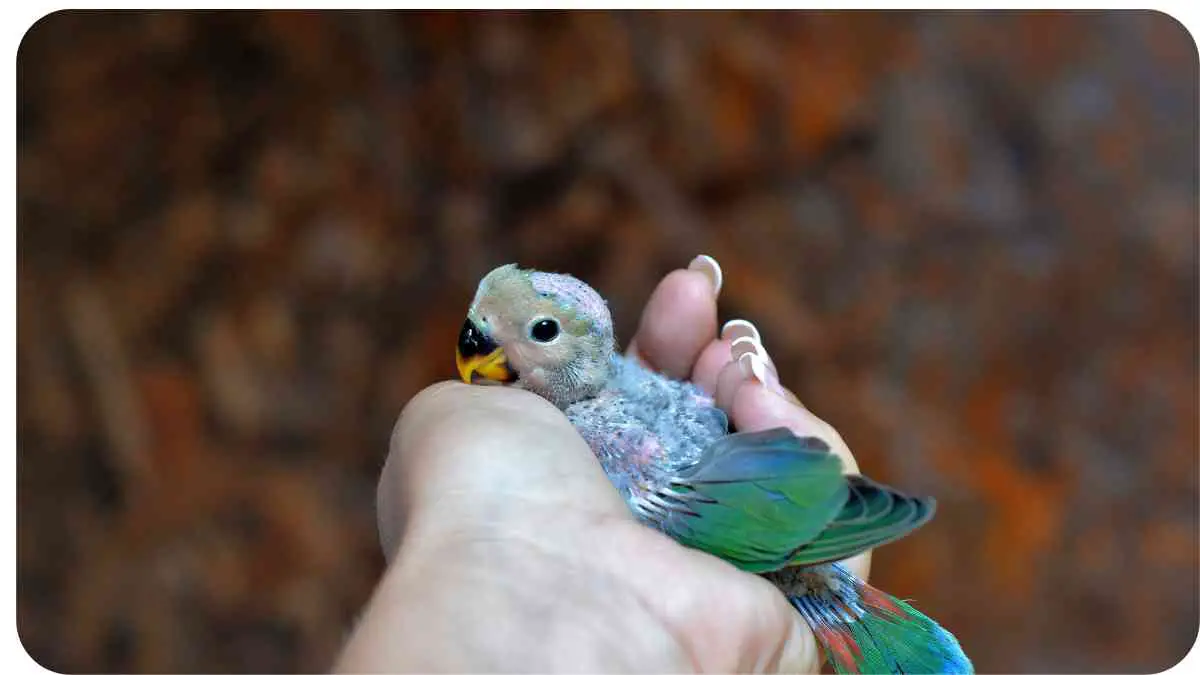Birds have long captured our fascination with their vibrant colors, enchanting melodies, and diverse species. The unique bond between birds and humans goes beyond mere observation; it’s a rich tapestry woven with threads of understanding, trust, and companionship.
In this article, we delve into the intricate dynamics of the affectionate connection shared between humans and our feathered friends.
| Takeaway |
| Understanding the intricate language of feathers enhances communication with birds. |
| The psychological benefits of avian companionship contribute to stress reduction and increased well-being. |
| Building trust with birds involves patience, consistency, and respecting their individual personalities. |
| Birds hold symbolic significance in diverse cultures, reflecting their deep connection with humanity. |
| Despite challenges, the joy and fulfillment of bird companionship create lasting memories for bird owners. |
| Optimal bird care includes a well-balanced diet, mental stimulation, and regular veterinary check-ups. |
| Individuals can contribute to bird conservation through supporting organizations and adopting sustainable practices. |
| The future of bird-human bonds lies in technological innovations, citizen science, and global conservation efforts. |
| Exploring forums and articles provides valuable insights and a sense of community for bird enthusiasts. |
2. The Avian Connection: A Bird’s Eye View
2.1 The Language of Feathers
Birds communicate in ways both subtle and profound. Feathers, in particular, play a crucial role in conveying emotions and intentions. Understanding the language of feathers is like deciphering a secret code that brings us closer to our avian companions.
Birds convey love through unique gestures, from tender preening to synchronized flights. Witness the beauty of avian affection and explore more on Unified Birds.
2.2 Understanding Bird Behavior

To truly connect with birds, one must grasp the intricacies of their behavior. From courtship rituals to territorial displays, each action tells a story. Let’s explore common bird behaviors and their interpretations in the table below:
Table 2.4: Common Bird Behaviors and Interpretations
| Behavior | Interpretation |
| Feather Preening | Contentment and Relaxation |
| Head Bobbing | Excitement or Curiosity |
| Wing Flapping | Expression of Joy or Territory Assertion |
| Vocalizations | Communication of Various Emotions |
2.3 Mutual Benefits of Bird-Human Interaction
The bond between birds and humans is mutually enriching. Birds provide companionship and joy, while humans offer care, protection, and a sense of belonging. This symbiotic relationship forms the foundation of a unique connection.
Delve into the heartwarming world of maternal love in diverse bird species. Discover how mother birds nurture their young with care and devotion at Unified Birds.
2.4 Table: Common Bird Behaviors and Interpretations
| Behavior | Interpretation |
| Nest Building | Preparation for Mating or Nesting |
| Beak Grinding | Sign of Comfort and Relaxation |
| Tail Wagging | Indicates Excitement or Playfulness |
| Regurgitation | Displays Affection and Bonding |
Now that we’ve uncovered the nuances of bird behavior, let’s move on to exploring the science behind the unique companionship shared between birds and humans.
3. The Science Behind Avian Companionship
3.1 Psychological Impact on Humans
Owning a pet bird has been scientifically proven to have positive effects on human mental health. The companionship of birds can alleviate stress, reduce feelings of loneliness, and contribute to an overall sense of well-being.
3.2 Emotional Intelligence in Birds
Birds, often underestimated in terms of intelligence, possess remarkable emotional intelligence. They can sense and respond to their human companion’s emotions, fostering a deep and empathetic connection.
3.3 How Birds Enhance Well-being
Birds contribute to the well-being of their human counterparts in multifaceted ways. The presence of a feathered friend can lead to increased physical activity, improved mood, and even lower blood pressure.
Explore the fascinating realm of monogamy in birds, where lifelong bonds are forged through shared experiences. Uncover the secrets of avian commitment at Unified Birds.
3.4 Table: Psychological Benefits of Bird Ownership
| Benefit | Description |
| Stress Reduction | Interacting with Birds Lowers Cortisol Levels |
| Companionship | Decreases Feelings of Loneliness |
| Cognitive Stimulation | Engages Owners in Observing and Understanding Behaviors |
| Sense of Purpose | Fosters Responsibility and Routine |
| Benefit | Description |
| Increased Social Interaction | Birds Facilitate Social Connections Among Owners |
| Emotional Support | Provides Comfort and Support During Challenging Times |
| Enhanced Mood | Triggers Release of Endorphins, Elevating Mood |
| Mindfulness | Promotes Present-Moment Awareness and Relaxation |
Understanding the psychological benefits of bird ownership is crucial, but building a bond with these feathered friends requires trust. Let’s explore the delicate art of establishing and nurturing trust between humans and birds.
4. Building Trust: A Two-Way Street
4.1 Gaining a Bird’s Trust
Earning a bird’s trust involves patience, consistency, and a deep understanding of their individual personalities. By respecting their boundaries and providing a secure environment, a bond of trust begins to form.
4.2 Establishing a Comfortable Environment
Creating a safe and stimulating living space is key to a bird’s well-being. From suitable cage setups to enriching toys, every element contributes to a bird’s comfort and happiness.
Experience the heartwarming journey of young birds as they develop emotional bonds through play and affectionate interactions. Discover the magical world of avian emotions at Unified Birds.
4.3 The Role of Routine and Consistency
Birds thrive on routine. Consistency in feeding times, play sessions, and interactions establishes a predictable environment that fosters trust and a sense of security.
4.4 Table: Tips for Building Trust with Your Feathered Friend
| Tip | Description |
| Slow Movements | Avoid Sudden or Startling Actions |
| Positive Reinforcement | Reward Trusting Behaviors with Treats or Affection |
| Respect Personal Space | Allow Birds to Initiate Contact |
| Gentle Vocal Interactions | Speak Softly and Calmly to Establish Comfort |
Building trust sets the stage for a fulfilling and harmonious relationship with your avian companion. Now, let’s explore the diverse ways birds are revered and integrated into various cultures around the world.
5. Feathered Friends in Different Cultures
5.1 Symbolism of Birds in Various Traditions
Birds hold symbolic significance in numerous cultures. From messengers of deities to representations of freedom, the role of birds varies widely. Exploring these cultural perspectives provides a deeper appreciation for the diverse connections between birds and humanity.
Dive into the social dynamics of birds as they express affection through grooming and cuddling behaviors. Unveil the significance of these interactions at Unified Birds.
5.2 Birds as Messengers and Symbols of Freedom
In many cultures, birds are regarded as messengers between the earthly and divine realms. The image of a bird in flight often symbolizes freedom, transcending physical and spiritual boundaries.
5.3 Cultural Practices Involving Birds
Various cultures incorporate birds into rituals, ceremonies, and folklore. The significance of specific bird species can range from symbols of good fortune to warnings of impending change.
5.4 Table: Birds in Different Cultures
| Culture | Bird Symbolism |
| Ancient Egypt | Falcon – Symbol of Solar Deity Ra |
| Native American | Eagle – Messenger Between Humans and the Creator |
| Chinese Tradition | Crane – Symbolizes Longevity and Good Luck |
| Greek Mythology | Owl – Associated with Wisdom and Athena, the Goddess of Wisdom |
Understanding the cultural contexts enriches our perception of the intricate relationships humans have forged with birds throughout history. As bird companionship continues to evolve, it’s essential to recognize both the challenges and rewards it brings.
6. Challenges and Rewards of Bird Companionship
6.1 Common Challenges Faced by Bird Owners
Owning a bird comes with its unique set of challenges. From dietary considerations to behavioral issues, addressing these challenges requires dedication and a commitment to understanding your feathered friend.
6.2 Overcoming Challenges and Building Resilience
Navigating challenges in bird ownership often involves learning and adapting. Whether it’s addressing health concerns or modifying the living environment, overcoming obstacles strengthens the bond between bird and owner.
6.3 Joyful Moments with Avian Companions
Despite challenges, the joy and fulfillment of bird companionship are unparalleled. Cherished moments of shared laughter, playful antics, and the simple pleasure of a bird’s presence create lasting memories.
6.4 Table: Handling Common Bird Owner Challenges
| Challenge | Solution |
| Excessive Chewing | Provide Suitable Chew Toys and Regularly Trim Beak |
| Feather Plucking | Address Underlying Stressors and Consult a Vet |
| Screaming Behavior | Implement Positive Reinforcement Training |
| Health Concerns | Schedule Regular Veterinary Check-ups |
| Challenge | Solution |
| Aggressive Behavior | Identify Triggers and Implement Behavior Modification |
| Loneliness | Introduce Enrichment Activities and Regular Social Interaction |
| Cage Size and Setup | Provide Adequate Space and Stimulating Environment |
| Training Difficulties | Use Positive Reinforcement and Patience |
Navigating these challenges requires a balance of knowledge, patience, and a genuine love for your feathered companion. As we continue our journey, let’s explore expert tips for optimal bird care.
7. Expert Tips for Optimal Bird Care

7.1 Nutrition and Diet Essentials
A well-balanced diet is fundamental to a bird’s health. Understanding the nutritional needs of your specific bird species ensures they receive the vitamins and minerals necessary for their well-being.
7.2 Enrichment Activities for Mental Stimulation
Birds are intelligent and curious creatures. Providing enrichment activities, such as puzzle toys and interactive games, stimulates their minds and prevents boredom.
7.3 Veterinary Care and Regular Check-ups
Regular veterinary check-ups are crucial for maintaining your bird’s health. A proactive approach to healthcare includes vaccinations, routine examinations, and early detection of potential issues.
7.4 Table: Nutritional Guidelines for Popular Pet Bird Species
| Bird Species | Dietary Recommendations |
| Budgerigar | High-Quality Pellets, Fresh Vegetables, and Limited Seeds |
| Cockatiel | Balanced Diet with Calcium Supplements for Egg-Laying Females |
| African Grey Parrot | Nutrient-Rich Pellets, Fresh Fruits, and Nuts in Moderation |
| Macaw | Variety of Nuts, Seeds, and Fresh Fruits |
| Bird Species | Dietary Recommendations |
| Lovebird | Balanced Diet with Emphasis on Leafy Greens and Berries |
| Conure | Pellets, Fresh Vegetables, and Occasional Fruit Treats |
| Cockatoo | Variety of Nuts, Low-Fat Pellets, and Fresh Vegetables |
| Finch | High-Quality Seed Mix, Fresh Greens, and Calcium Supplements |
Understanding the specific dietary needs of your feathered friend is essential for their overall health and longevity. As we peer into the future of bird-human bonds, let’s explore the evolving landscape of conservation efforts and technological innovations.
8. The Future of Bird-Human Bonds

8.1 Conservation Efforts and Citizen Science
As our awareness of environmental challenges grows, individuals play a crucial role in bird conservation. Citizen science initiatives empower ordinary people to contribute valuable data, aiding researchers in understanding and protecting avian species.
8.2 Technological Innovations in Avian Research
Advancements in technology offer new insights into avian behavior, migration patterns, and population dynamics. From GPS tracking to bioacoustic monitoring, these innovations enhance our understanding of birds and their ecological roles.
8.3 How Individuals Can Contribute
Whether through supporting conservation organizations, participating in citizen science projects, or adopting sustainable practices, individuals can make a significant impact on preserving bird habitats and biodiversity.
8.4 Table: Conservation Organizations and Their Impact
| Organization | Focus Area | Impact |
| Audubon Society | Habitat Conservation, Education | Protects Critical Bird Habitats, Advocates for Environmental Policies |
| BirdLife International | Global Conservation, Research | Works to Prevent Extinctions and Safeguard Bird Species Worldwide |
| Cornell Lab of Ornithology | Scientific Research, Education | Advances Ornithological Knowledge, Engages Public in Bird Conservation |
| World Parrot Trust | Parrot Conservation, Advocacy | Works to Protect Endangered Parrot Species and Their Habitats |
| Organization | Focus Area | Impact |
| National Audubon Society | Bird Advocacy, Conservation | Promotes Bird-Friendly Policies, Advocates for Clean Energy |
| International Union for Conservation of Nature (IUCN) | Global Conservation, Red List | Provides Comprehensive Assessments of Species’ Conservation Status |
| The Peregrine Fund | Raptor Conservation | Successfully Restores Peregrine Falcon Populations |
| Partners in Flight | Migratory Bird Conservation | Collaborates on Conservation Strategies for Neotropical Migratory Birds |
Understanding and supporting these organizations is a tangible way individuals can contribute to the conservation of bird species and their habitats. As we conclude our exploration, let’s reflect on the diverse aspects of the unique bonds shared between birds and humans.
9. Conclusion
In the intricate tapestry of bird-human bonds, we’ve uncovered the language of feathers, the psychological benefits of avian companionship, the challenges and rewards of bird ownership, and the rich symbolism of birds in different cultures.
Through expert tips and a glimpse into the future of bird conservation, we’ve painted a comprehensive picture of the profound connections we share with our feathered friends.
As you embark on your journey with avian companionship or deepen your existing bond, remember the importance of patience, understanding, and mutual respect.
The world of birds is one of wonders, challenges, and immeasurable joy may your relationship with these incredible creatures continue to flourish.
Further Reading
- The Human-Avian Bond – Insights from IAABC Foundation
- Explore a comprehensive resource delving into the intricate dynamics of the bond between humans and birds. Gain insights from experts in the field of avian behavior and companionship.
- How Do Birds Show Affection to Humans?
- Discover the subtle and fascinating ways in which birds express affection towards their human companions. This resource provides valuable tips on interpreting and reciprocating avian affection.
- The Intense Bond Between Humans and Birds – Avian Avenue Forums
- Engage with a community of bird enthusiasts sharing experiences, anecdotes, and advice on the profound connections forged between humans and their feathered friends.
FAQs
How do birds communicate with humans?
Birds communicate with humans through a combination of vocalizations, body language, and feather displays. Paying attention to these cues helps in understanding their needs and emotions.
What are common challenges in bird ownership?
Common challenges in bird ownership include addressing behavioral issues, providing a balanced diet, creating a stimulating environment, and handling potential health concerns.
How can I build trust with my pet bird?
Building trust involves slow movements, positive reinforcement, respect for personal space, and gentle vocal interactions. Consistency in routine also plays a key role.
Are there cultural variations in bird symbolism?
Yes, various cultures attribute different meanings to birds. For example, in Native American traditions, eagles are seen as messengers between humans and the Creator.
What are some conservation organizations supporting bird habitats?
Organizations like Audubon Society, BirdLife International, and The Peregrine Fund focus on habitat conservation, global research, and specific species conservation to safeguard bird populations and ecosystems.

Hello! I’m Hellen James, and I’m a birdwatcher and birder. I have a personal interest in bird behavior and classifications and have been following the latest research on the topic for years.


